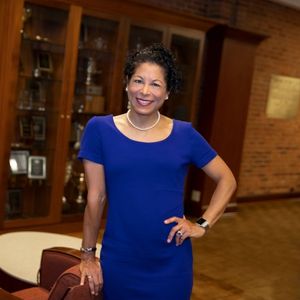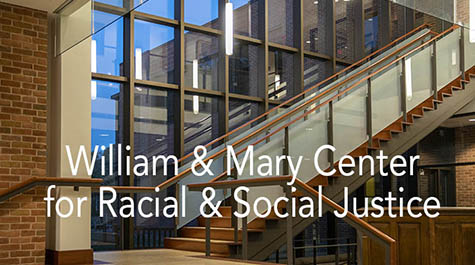Leading in the Service of Justice and Equity
Across the university, William & Mary faculty members have long forged influential scholarship around issues of race and social justice — but often in their own “silos,” as Professor of Law Vivian Hamilton puts it.
The year-old Center for Racial & Social Justice, housed within the Law School, is knocking down those walls to “broaden our impact and bring together the tremendous expertise we have across the disciplines,” she explains.
 "We have people who are doing this profound work, but we hadn’t been talking to one another and working together,” says Hamilton, the Center’s director. “By forming collaborations across the university, we’re exponentially increasing and magnifying the effect that William & Mary will have in advancing these issues.”
"We have people who are doing this profound work, but we hadn’t been talking to one another and working together,” says Hamilton, the Center’s director. “By forming collaborations across the university, we’re exponentially increasing and magnifying the effect that William & Mary will have in advancing these issues.”
Supported by Law School Dean A. Benjamin Spencer and university Provost Peggy Agouris, Hamilton set the groundwork over the past year for the Center’s long-term growth and impact. She long envisioned such a hub at William & Mary, building on the nation’s racial-justice awakening in summer 2020 to gather momentum for the idea.
In formal terms, the Center’s mission prioritizes “racial and social justice by educating students and the broader community, building students’ capacity to engage in antiracist and social justice work, and engaging in legal and multidisciplinary research and advocacy aimed to inform the public, advocates, and policymakers — both in the Commonwealth of Virginia and nationwide.”
In practical terms, that means bringing together faculty members and students for programs and events, cultivating research teams to dig into social challenges, and drawing in alumni and others who are drawn to the work. The Center counts four affiliated faculty members — in addition to Dean Spencer — who have joined to reinforce its work.
Among the Center’s progress and projects:- Creating a national resource to advance criminal justice: Adam M. Gershowitz, who is the R. Hugh and Nolie Haynes Professor of Law, and Center research fellow Julian Miller are researching prosecutorial misconduct. With faculty at the Duke Law School Wilson Center for Science and Justice, they are creating a searchable, national database of instances when prosecutors flouted their obligation to turn over exculpatory evidence. “By holding prosecutors accountable, we can increase compliance with laws that are in place to guarantee that defendants are afforded a fair process,” Hamilton explains.
- Giving voice to an Asian legacy: Hamilton is vice-chair of W&M’s Asian Centennial Committee, which is engaged in a year-long research and programming effort to commemorate the centennial admission of Asian students at William & Mary. The committee organizes celebrations of the milestone while developing research into APIM communities. A related research project is examining the legal infrastructure that affects Asian and Asian American populations in immigration and in admission or enrollment in universities, especially within the Commonwealth. Further, the project will examine historic policies of William & Mary and how they may have affected the lives of Asian and Asian American students.
The project has begun holding community events to recognize the contributions of Asians and Asian Americans at the university. Congressman Bobby Scott, who is the first American of Filipino ancestry to serve as a U.S. representative and the first Black representative from Virginia since Reconstruction, appeared as a speaker. The project also held a gathering centered on halting anti-Asian hate after the March 2021 spa shootings in Atlanta, where six Asian women were killed.
The events “showed unity and that the university supported our students, and especially our Asian and Asian American students,” Hamilton says. - Amplifying graduate research: With robust participation from the Law School and the School of Education, the Center hosted a new graduate research symposium to highlight graduate students’ work across the spectrum of racial and social justice.
- Advancing equity in education: Hamilton, together with faculty colleagues Natoya Haskins (School of Education) and Jody Allen (Arts & Sciences—History), and graduate and undergraduate students, is embarking on a project to study the disparate experiences of students of color in elementary and secondary schools in the Commonwealth. Researchers will engage with community organizations on interventions for improving student experiences and outcomes.
- Putting a spotlight on diverse history: With backing from Dean Spencer, the Center has put up exhibits at the Law School that honor diverse elements of William & Mary’s history. A summertime exhibit featured Black history at the Law School. An upcoming exhibit is spotlighting Asians and Asian Americans.
- Developing a university-wide mentoring program: The Society of 1918 has provided grant support for a new initiative to connect students with alumni mentors. Founded on the occasion of the centennial celebration of the admission of women to William & Mary, the Society is committed to growing the engagement, leadership and philanthropy of women.
In its second full year, the Center has “begun to institutionalize itself in a way that’s more visible and predictable” across the university community, Hamilton notes. Among its plans, the Center will formalize a speaker series that has included panel discussions of experts on topics including reproductive rights, critical race theory, and the rights of transgender students. The Center also plans to host a daylong symposium on LGBTQ+ rights.
“After adopting new tools to teach and learn on campus during the pandemic, we’re in a better position to leverage virtual connections like Zoom and can take advantage of both worlds — in person and online,” Hamilton says.
Learn more about the Center for Racial & Social Justice at law.wm.edu/socialjustice.
About William & Mary Law School
Thomas Jefferson founded William & Mary Law School in 1779 to train leaders for the new nation. Now in its third century, America’s first law school continues its historic mission of educating citizen lawyers who are prepared both to lead and to serve.
